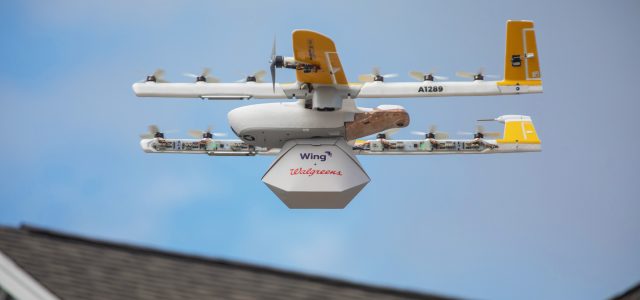There is little doubt that the future of drones includes uncrewed aircraft delivery services. From online ordering to life-saving medications, our skies will soon teem with drones. Several of the world’s leading companies have been in a race against each other to be the first to provide a drone delivery service. Over the last few years, giants such as Google, Amazon, UPS, and Uber have poured enormous resources into the dream that is drone delivery.
The potential benefits of delivering goods through drones are enormous. Speed of delivery, accessibility, and environmental impact are just a few of the areas likely to see gains. According to an economic study released by the New York-based research firm AlphaBeta, drone delivery has the potential to reduce greenhouse gas emissions by 99 percent when compared to cars and trucks.
If you are keeping up with current events, you have likely heard that Wing, a subsidiary of Alphabet Inc. (now the parent company of Google) launched the first successful commercial drone delivery. On October 18, 2019, Wing delivered a FedEx package containing a birthday gift to a home in Christiansburg, Virginia. That flight was the first FAA-approved door-to-door drone delivery in United States history. To accomplish this feat, Wing partnered with Walgreens and Virginia Polytechnic Institute.
Outside of the United States, Wing is also conducting testing and commercial operations abroad. Projects in Finland and Australia are proving the platform’s success across the globe. In addition to the drone, the company has created software to help drone pilots traverse the skies safely. Their application, OpenSky, is verified by Australia’s Civil Aviation Safety Authority (CASA) and derived from the OpenSky platform. It provides Australian pilots with the information needed to comply with regulations and plan flights safely and efficiently.
With this historical event in mind, we reached out to learn more about Wing, and what the future holds for drone delivery.
BEHIND THE SCENES
Wing came from the semisecret Google X, now known simply as “X.” The secret research team at Alphabet Inc. has given birth to driverless cars, Google Glass, and Google Brain. X works to solve some of the world’s most challenging problems with the goal of a tenfold impact solution.
Six years ago, X began looking at drones, and created Project Wing to address the problem of traffic congestion in cities and CO2 emissions attributable to the transportation of goods, and to increase consumer access to products.
The company’s solution to these problems is an autonomous delivery drone. The Wing drone weighs 10.6 pounds and can carry a package under 3.3 pounds. The wingspan is 3.3 feet, and the platform is capable of speeds up to 65 miles per hour. The maximum flying range is 3.7 miles. With a cruise altitude of 100 to 150 feet and a hovering altitude of 23 feet, the drone stays well outside of crewed aircraft airspace. It should be noted that the current speed, payload weights, and maximum flying ranges of the drone are only those set for the United States, and not necessarily the limitations of the aircraft.
For six years, Wing has designed and built everything from the drone to the navigation system. The aircraft and supporting systems have been tested on three continents with more than 80,000 test flights since 2013, including thousands of customer deliveries.
Since April 2017, Wing has been working closely with the FAA. As part of the Unmanned Aircraft System (UAS) Integrated Pilot Program (IPP), the company has established the characteristics of its operation, which make it safe. During this period, the team has been focused on demonstrating that its operation, aircraft, personnel, and procedures meet the high safety standards established by the FAA.
In April 2019, the company was certified as an air carrier by the FAA, becoming the first drone operator to do so. The October 18 flight is their next great achievement. Through their partnership with Virginia Tech, the company has developed a better understanding of the impact of drone delivery across the United States. Research with the university has yielded some impressive initial findings.
For the study area in the Blacksburg-Christiansburg metropolitan region, drones are capable of delivering goods faster, while increasing accessibility without sacrificing sustainability. Wing’s drone could produce a 27.4 percent increase in sales per year for businesses participating in the service. The initial findings for mature metropolitan markets are even more promising.
With a high adoption rate of Wing, findings suggest that within five years, up to 3,385 cars could be taken off the road, the equivalent of 38.9 million miles per year. Individual customers could save as much as 44.6 hours annually by avoiding travel and waiting times. Approximately 40.2 tons of carbon dioxide and 1,849 oak trees could be saved. In total, customers could see $46.6 million in time savings each year.
THE FUTURE IS HERE
Overwhelming benefits like those above would have been laughable just five years ago, but today they are becoming a reality.
As part of the U.S. Department of Transportation’s UAS IPP, the company plans to continue to stay relatively small until the DOT’s program ends in 2020 and then gradually grow based on feedback from the community.
As for what the future holds, Wing spokesperson Alexa Dennett says, “Wing is looking forward to bringing a faster, more accessible, and more sustainable method of delivery to households around the world.”
Wing’s historic firsts in drone delivery are most likely only the beginning of their successes. Perhaps in the coming years, Wing drones will become a common sight in the sky, and our preferred method of getting the goods we need safely and sustainably.
By David Daly; Photos Courtesy of Google Wing




















while in general a great thing!
The risks outweigh a physical and practical implication in any medium or larger US city.
The real problem is that at the end you have to make money and that is where the costs outweigh a practical implementation.